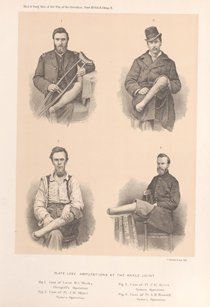Title: Russell, A. K.
Source text: The Medical and Surgical History of the War of the Rebellion. (1861-65.), Part 3, Volume 2 (Washington, DC: Government Printing Office, 1883), 596-597.
Civil War Washington ID: med.d2e22798
TEI/XML: med.d2e22798.xml
CASE 871.—Private A. K. Russell, Co. H, 1st Massachusetts Heavy Artillery, aged 43 years, was wounded at Spottsylvania, May 19, 1864, and admitted to Emory Hospital, Washington, three days afterwards. Acting Assistant Surgeon J. E. Janvrin reported: "Gunshot wound of left foot, the ball entering the heel posteriorly, passing forward through the os calcis and astragalus, and making its exit anteriorly on the dorsal surface of the foot. The os calcis and astragalus together with the metatarsal bones were comminuted, and, according to the patient's statement, the soft parts were very much lacerated. Chloroform was administered, and Syme's operation was performed on the day of the injury. When admitted to Emory Hospital the sutures had given way and the flap was pendant, with unhealthy discharges and tendency to slough. Adhesive straps and cold-water dressings were applied, and subsequently linseed, charcoal, and yeast poultices were used. Alteratives, tunics, and stimulants were administered, the patient being much exhausted and suffering from loss of appetite, with derangement of the system generally. On June 3d the parts were thoroughly cleansed, and a flat padded splint was applied to the anterior surface of the leg, extending beyond the stump, after which adhesive straps were passed from beneath the leg across the flap and carried over the end of the splint and fastened. These were gradually shortened as the healing process went on, thus removing the tension and weight of the flap from the anterior edge of the wound. By July 12th the patient was doing well and the granulations were covering the bone. About August 18th the stump had nearly closed and the patient's general health was good. Two weeks afterwards he left for his home on furlough. The success attending this case is attributed in a large measure to the method adopted for supporting the flap." The patient subsequently entered the general hospital at Readville, whence he was discharged from service June 2, 1865, and pensioned. After leaving the service he was furnished with an artificial foot. A photograph of the stump, taken three months after the date of the amputation, and contributed by Surgeon N. R. Moseley, U. S. V., is represented in FIGURE 4 of PLATE LXXV, opposite page 596. The man subsequently underwent a second operation, which was certified to by the Surgeon General of the State of Massachusetts, who communicated the following on January 26, 1871: "The pensioner has sustained re-amputation six inches below the knee, which was performed by Dr. C. N. Chamberlain, of Lawrence, late surgeon U. S. V., assisted by Dr. G. W. Garland, the case being at the time under my observation." In his subsequent application for commutation the pensioner described the stump as being in a good condition. His pension was paid December 4, 1880.
